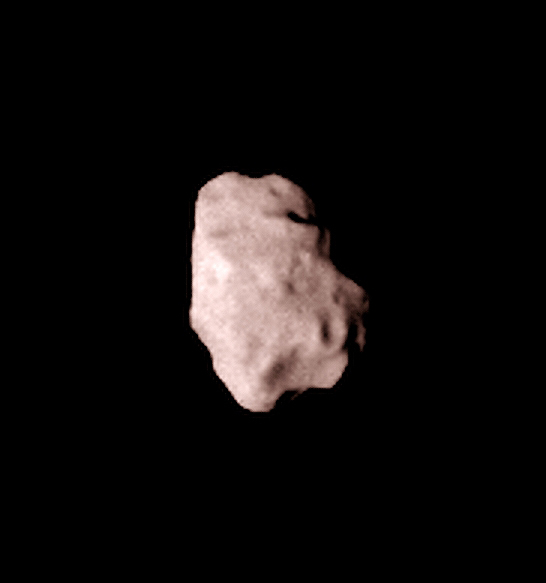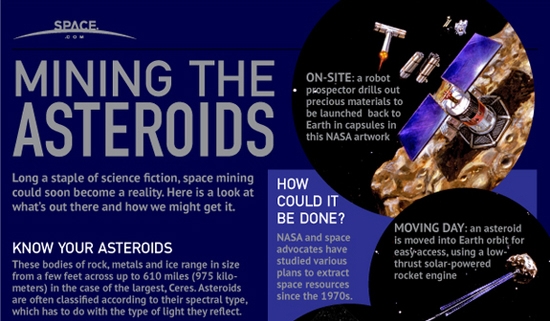All About Asteroids

Asteroids are widely believed to be the rocky leftovers from the formation of our solar system. They can range in size from a few meters in diameter to several hundred meters across. While most asteroids inhabit the Asteroid Belt between Mars and Jupiter, the orbits of some asteroids can take an elliptical that brings them into the inner solar system and possibly even interact with Earth. In fact, a giant asteroid is believed to be responsible for the extinction of the dinosaurs. Could it happen again? Many astronomers believe so. In fact, there have been recent cases of asteroids passing closer to the Earth than the Moon’s orbit. Stay tuned…
Asteroids Up Close

Fun Facts About Asteroids
- Ceres is the largest object in the asteroid belt and is formally classified as a dwarf planet. It was discovered by Giuseppe Piazzi in January 1801. Initially, he thought he had discovered a new comet. Subsequent observations revealed that it was actually a small world. Ceres was the first discovered object in the asteroid belt and contains about 25% of the known mass in the asteroid belt.
- 4 Vesta is the largest asteroid in our solar system. Its dimensions are 578 km by 458 km and it has a mass of 2.67 X 10^20 kg. It is bright enough to be observed with a binoculars and there have been occasional reports of sightings with the naked eye. It is believed that the radioactive decay of aluminum-26 heated Vesta enough to produce lava flows at some point in the ancient past and may be the source of many meteorites that got blasted off when Vesta collided with other asteroids.
- Mars’ moons may actually be captured asteroids. Occasionally, asteroids will get pulled into orbit by a planet’s gravity. Deimos and Phoebos are two of these.
- Jupiter may protect the inner planets from major collisions with asteroids. Jupiter is the largest planet in our solar system and also close enough to the asteroid belt for its gravity to influence their orbits. This helps shepherd the asteroids and prevent most collisions.
- Groups of asteroids known as Hirayama families may be the remains of larger asteroids that were broken apart by collisions. They share the same orbit around the sun and many of the same characteristics. There are around 20 known Hirayama families.
- Rogue asteroids whose orbits take them into the inner solar system are known as Apollo-Amor objects. The Amor objects do not travel very far into the inner solar system and may eventually collide with Mars. The Apollo objects will inevitably collide with the Sun or with another planet. It is estimated that Earth gets hit by a large Apollo object once every 250,000 years. Most of these are not large enough to cause a mass extinction on the level of the dinosaurs but can still do a significant amount of damage. Some observatories like Lowell Observatory have programs for watching Apollo objects that could pose a danger to Earth.
- The Trojan Asteroids are asteroids that have been trapped at specific points around Jupiter known as Lagrangian points. These points are places where Jupiter’s gravity field interacts with the Sun’s to create zones that are difficult to escape from once an object falls into it. Similar asteroids have been found in similar Lagrangian points around Mars and Neptune. In 2011, NASA’s WISE telescope discovered Earth’s first known Trojan asteroids. Earth’s Trojans are notoriously hard to spot because they reside in regions where the sun’s glare makes them had to see.
Types Of Asteroids
- C-type asteroids are dark asteroids with albedos smaller than 0.06 and are made of carbon-rich compounds. Most reside in the outer solar system.
- M-class asteroids are bright asteroids that are believed to be rich in iron and other metals. They may be the remains of the original planetesimals’ metallic cores.
- S-class asteroids are rocky asteroids with albedos of 0.1 to 0.2. They are slightly reddish in color.
The Late, Late Heavy Bombardment Period
Sponsored by SETI, Bill Bottke discusses a period in the early history of the solar system when the planets were being heavily bombarded by asteroids and comets.
The Origin of Asteroids
The asteroid belt exists in a zone wide enough that you would think there would be another planet there. The old astronomers thought there might be one and Ceres was actually smaller than expected. The subsequent discovery of Pallas, Juno and Vesta made it clear that there was actually a series of objects in that zone and there are now more than 100,000 known asteroids.
Many astronomers now believe that there was never actually a planet there. Instead, the asteroid belt may be the remains of a series of planetesimals that were torn apart by a series of collisions. Ceres may be the last remaining dwarf planet in that zone and it is also smaller than it used to be. The collisions, along with gravitational interactions with the planets, drove many asteroids out of the asteroid zone. Many of those collided with planets and the Sun. Those that haven’t are scattered throughout the inner and outer solar system, orbit planets, or were ejected from the solar system.
Some Asteroids Are Dangerous
The Tunguska event was a massive explosion that occurred in Siberia, Russia on June 30, 1908. The explosion was caused by the airburst of a large asteroid or comet, and it is believed to have been the largest impact event in recorded history. The explosion occurred in a remote area of Siberia, and while there were no known human fatalities, the explosion felled an estimated 80 million trees over an area of 2,150 square kilometers (830 sq mi). The event is named after the Tunguska River, which runs through the region where the explosion occurred.
Scientists continue to study the Tunguska event to better understand the effects of asteroid impacts on Earth and to develop strategies for mitigating the risk of future impacts. Other famous asteroid strikes throughout history and prehistory include:
- The Chicxulub impact, which occurred 66 million years ago and is thought to have contributed to the extinction of the dinosaurs.
- The Chelyabinsk meteor, which exploded over Russia in 2013 and caused significant damage to buildings and injured over 1,000 people.
- The Meteor Crater in Arizona, which was formed approximately 50,000 years ago by the impact of a small asteroid.
- The Henbury Craters in Australia, which were formed by the impact of multiple asteroids approximately 4,700 years ago.
In 2013, an asteroid called 2013 TV135 came close to colliding with Earth, but it passed by at a safe distance. In 2020, an asteroid called 2020 SW flew by Earth at a distance of just over 27,000 miles (44,000 kilometers), which is much closer than the Moon. While these events were not dangerous, they serve as reminders of the need to track asteroids and be prepared for the possibility of future impacts.
Scientists have also expressed concern about other potentially dangerous near-Earth objects like comets and asteroids that may pose a hazard to Earth. In late 2022, the DART mission successfully tested a proposed method for deflecting dangerous asteroids by impacting an asteroid that was orbiting another asteroid. NASA is also building the NEO Observer to hunt for asteroids that might pass through Earth’s orbit.
Preventing A Collision
If you’re one of those people who doesn’t support a robust space program, consider this video. You really don’t want to be on Earth when the next big one hits. Here’s some proposed ideas for deflecting the next “big one”.








